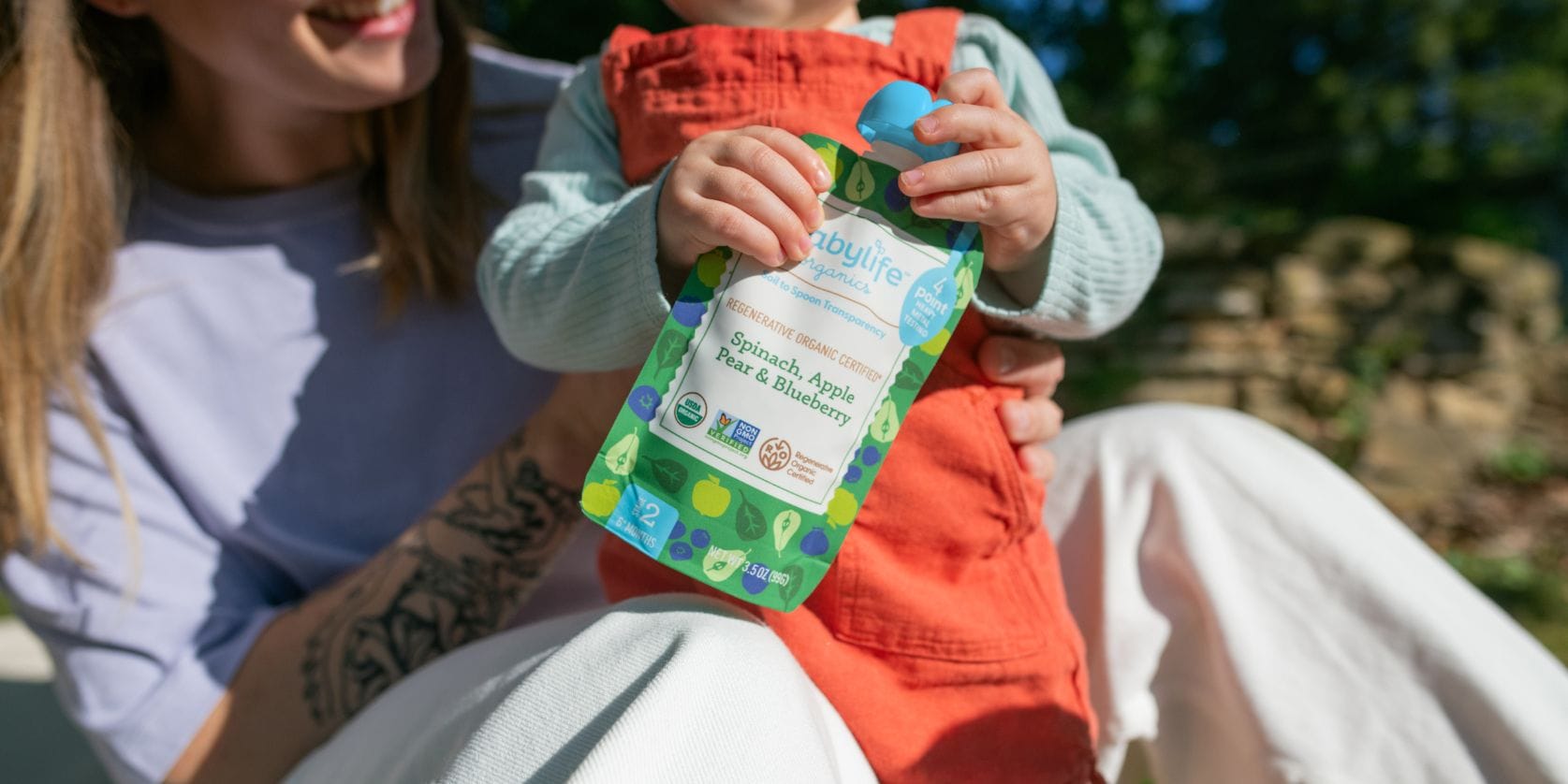Most baby food in the US—both store-bought and homemade, organic and conventional—is often an inadvertent source of toxic heavy metals. As a parent or caregiver, it’s tough to know what to do with that worrying information. How can you successfully limit your baby’s intake of heavy metals, like lead, cadmium, arsenic and mercury, which are linked to issues with neurological development and other health concerns? How can you trust that what you’re feeding your little ones is safe—when the problem is rampant? A new baby food company aims to address these concerns by offering unprecedented transparency.
Babylife Organics, launching today, is the first baby food brand to publicly report their heavy metal testing results—and share that information with consumers on every single jar or pouch via QR code.
Revolutionizing baby food safety
Babylife Organics is also the first baby food to be Regenerative Organic Certified, ensuring the soil used to grow their produce is as safe and clean as possible.
Heavy metals naturally occur in the earth’s crust, but can also be released through pollution. They can contaminate fruits and vegetables through tainted water and soil, which is difficult to avoid without regular testing.
“Heavy metals occur naturally in the soil, but some areas are more heavily contaminated than others,” Richard Harford, CEO of Babylife Organics, tells Motherly. “We are fortunate to source all of our produce from regenerative organic fields and wild orchards across Türkiye [Turkey]. This area of the world is home to some of the cleanest and safest soil on the planet, cared for by generations of farmers.”
Starting with the soil
Soil health is crucial in producing safer baby food. But the industry has struggled with complex supply chains, making it difficult to manage heavy metal contamination, Harford explains.
“There is no federal standard for testing in baby food—so really, most brands don’t even know they have a problem until someone else tests their food or perhaps they test it every-so-often at the finished product stage,” Harford says. “If there is a problem, it is incredibly difficult to figure out where the issue is coming from. This isn’t just a problem in conventional baby food—it impacts organic baby food too.”
Babylife Organics addresses this by testing at four stages—what they’re calling 4-point heavy metal testing: soil, raw ingredients, prepared ingredients, and the final product. They also employ regenerative farming practices, verified by the Regenerative Organic Alliance.

Harford emphasizes the importance of their comprehensive testing process: “For Babylife, it’s incredibly important to have control of each step of the production process. The first stage is testing the soil – tested once a year or during each planting season. The next step is testing raw ingredients from each harvest lot code, followed by prepared ingredients and ingredient blends. Finally, we test the finished, packaged product.”
He adds, “And because we test at four stages, we can easily identify any problems much earlier in the supply chain (e.g. the soil) so we can mitigate any issues before moving into production.”
Setting a new standard
Experts recommend minimizing children’s exposure to heavy metals due to potential health risks. The American Academy of Pediatrics (AAP) warns that chronic ingestion of heavy metals can harm developing brains.
With no federal standards for heavy metals in baby food, Babylife Organics looked to international benchmarks. “We looked at trusted sources around the world, and aligned to follow the European Union Food Safety Policy and the Clean Label Project’s First 1000 Days Promise—both superior standards for heavy metal levels in food that are more stringent than FDA standards which continue to be limited at best,” Harford says.
All of Babylife’s products meet or exceed those standards. Harford hopes that it sets off a sea change within the industry. “We hope that our high standards and commitment to transparency inspire other brands to do the same, and prompt the FDA to finally take action and partner with all of us on this important issue.”
How to use the QR code
Each Babylife Organics product comes with a unique QR code printed on the packaging. Harford describes the process: “When a consumer has a pouch or jar in hand, they can easily scan a QR code printed on the packaging and are linked to our website where they are directed to type in the lot code. The lot code is associated with unique finished goods heavy metal test results for that batch.”


You can then follow a few prompts to see a more detailed report—with specific numbers (not just a pass/fail declaration)—for the product you’ve purchased. You can even dig deeper with site content that further explains the levels reflected in your results and the standards the company measures against, Harford adds.
Where to buy
Babylife Organics’ line of baby food jars and pouches launches today exclusively at Whole Foods Market nationwide. Online ordering will be available soon through the company’s website.
Stage 1 jars feature single-ingredient flavors like apple or carrot or pear, while stage 2 pouches include blends like pear, strawberry & banana or carrot, pear, beet & blackberry. The products are certified USDA Organic and are also free from additives, including citric acid, water and artificial preservatives.
As concerns about heavy metals in baby food grow, Babylife’s approach to soil health and testing transparency could help parents make more informed decisions about what they feed their little ones—and potentially set a new standard for the industry as a whole.

